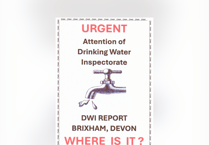REINFORCED Autoclaved Aerated Concrete (RAAC) has been in the news recently - this type of concrete was used to build a number of schools and other public buildings in the 1950s-1990s, writes MP Anne Marie Morris.
As advice from technical experts has evolved over time, there has been an ongoing programme of work to manage the risks of RAAC spanning governments of all colours since 1994. In Teignbridge no schools to date have been identified as having RAAC. That does not mean our aging buildings are trouble free!
In 2018 the Department for Education informed ‘responsible bodies’ (those responsible for schools – this would be Devon County Council or an academy trust) about the potential risks of RAAC. Responsible bodies were asked to identify any properties constructed using RAAC and to ensure that these properties were regularly inspected by a structural engineer. In 2022, the government then felt it was necessary to take a more directive approach and issued a questionnaire to all 22,000 schools across England asking them to identify whether they did or did not have RAAC.
The challenge grew once it became clear, following the ceiling collapse in a school over the summer holidays this year, that visual inspection alone was not adequate. Property in the risk period then had to undergo more invasive inspection.
As a member of the Public Accounts Committee, we challenged the Department for Education officials over the condition of school buildings back in July of this year and again in September. We were concerned not just with the number of schools identified with RAAC, but also those where it was still unclear if remedial work would be needed. Our concern was not just about health and safety and children’s education, but the impact on the Schools Rebuilding Programme already under pressure from asbestos work – and frankly the very large number of very old schools still used many years after the end of their predicted life span.
One hundred slots within the Schools Rebuilding Programme had been set aside as a buffer, should issues like RAAC emerge . But 174 schools have already been identified where there is a potential presence of RAAC. This exceeds the 100 slots set aside, and I asked officials in September what happens if there are more than 100 cases? Who funds it?
I was assured that precautionary steps had been taken to prioritise those school buildings with RAAC in the rebuilding programme and that additional capital funding had been identified to come from existing budgets should the need be greater.
But the consequence is the 100 spaces needed for old school buildings to be replaced for some other reason has either gone or been severely cut. That matters - we all saw the dire state of Kenton school after the early autumn floods. Definitely a candidate for a new school building!
But how have we got to a position where we don’t have a central database setting out the condition of our schools? Why did we have to send out questionnaires? It seems the responsibility rests with each individual accountable body – the county council or the academy trust.
There needs to be a much more proactive approach led by Government, and the Health and Safety Executive.
Clearly there is a role for schools and their responsible bodies to play in collecting the data. But schools only get what money the government gives them. What if it’s not enough? Government must have a duty to step in to ensure the health and safety of our children. The right balance must be struck, and I am not sure the current position is the right one.
As always, if you would like to book a surgery appointment (in-person or virtual) or raise a specific issue, please call my office on 01626 368277 or email [email protected] to arrange an appointment



-Beaver-Trust.jpeg?width=209&height=140&crop=209:145,smart&quality=75)

Comments
This article has no comments yet. Be the first to leave a comment.